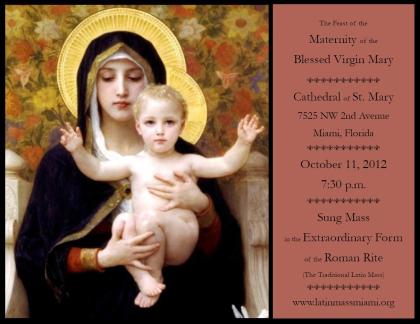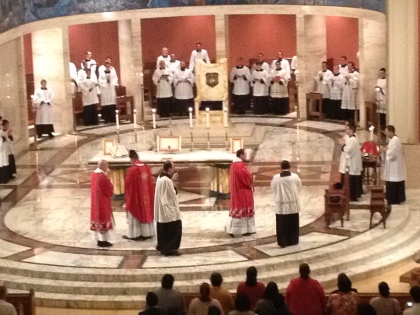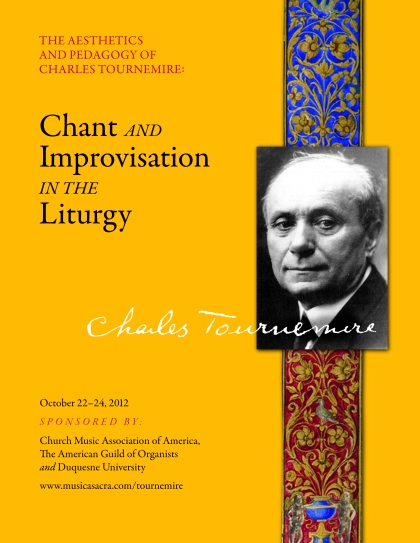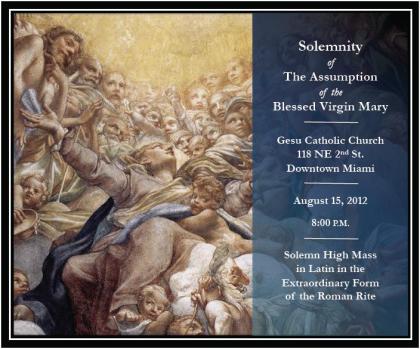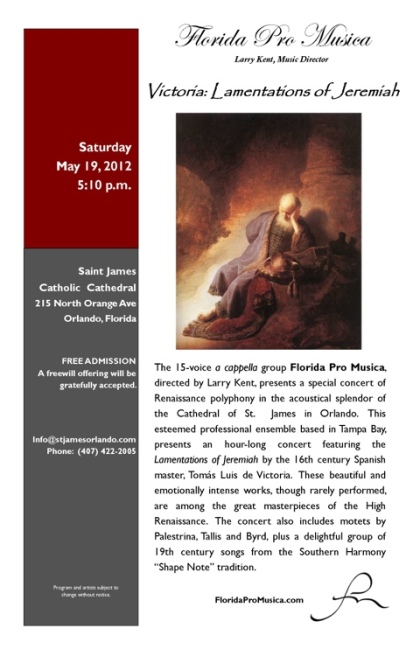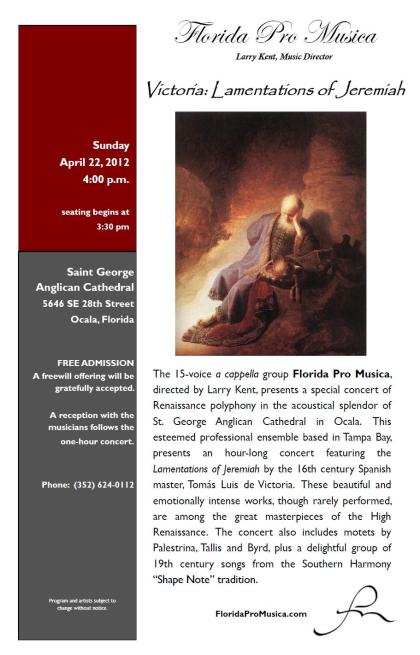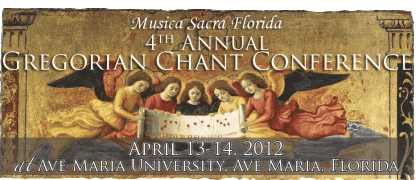Florida Pro Musica Season Finale!
March 28, 2013
Florida Pro Musica’s season finale is on Sunday, April 7, 2013, at 4:00 p.m. at Sacred Heart Catholic Church in downtown Tampa. This promises to be a very special event, featuring William Byrd’s “Mass for Four Voices.” The eight singers, directed by Larry Kent, will also be performing Renaissance motets by Palestrina, Lobo, Walter, and Isaac, and English madrigals by Bennet and Farmer. Also on the program are sacred motets by Franz Liszt and Anton Bruckner, two giants of the 19th century not well known for their works in this genre.
What: Florida Pro Musica, directed by Larry Kent – choral works including Byrd’s Mass for 4 Voices
When: Sunday, April 7, 2013 at 4:00 p.m. (approximately one hour)
Where: Sacred Heart Catholic Church, 509 North Florida Avenue, Tampa, Florida
Tickets: $20, general admission, available at the door or online at FloridaProMusica.com
Info: For information, directions, or to purchase tickets, visit FloridaProMusica.com or call (813) 494-4709.
The musicians on this concert are Meghan Alfaro, Rebecca Rinsema, Karen Western, Judy Vincent Kent, Stephen Rosser, George Western, Peter Baker, and Tim LaDue, directed by Larry Kent.
Florida Pro Musica – Free Gregorian Chant Concert
February 26, 2013
Musica Sacra Florida 2013 Gregorian Chant Conference
January 9, 2013
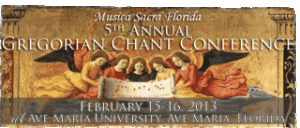
Musica Sacra Florida – 5th Annual Gregorian Chant Conference
Sponsored by the Florida Chapter of the Church Music Association of America
in conjunction with Ave Maria University
Friday, February 15th – Saturday, February 16th
Ave Maria University, Ave Maria Florida
The Conference Will Include
Workshops in:– Singing Gregorian Chant in English
– Incorporating Gregorian Chant into Parish Life
– Instruction for Priests and Deacons in Chanting the Mass in the New English Translation
– Church Documents & Sacred Music in the 20th and 21st Century
Choice of scholae for:
– Beginning/intermediate (men & women),
– Upper-level men,& upper-level women
Solemn High Mass in the Extraordinary Form on Friday evening with music provided by the AMU Music Department
Closing English sung Mass in the Ordinary Form on Saturday evening, celebrated by Most Rev. Frank Dewane, Bishop of the Diocese of Venice in Florida, with music provided by conference participants.
Advance registration online is required:www.musicasacra.com/florida
Registration fees are $60.00 (including materials and instruction), $15.00 for students with ID
Overnight accommodations will be available at AMU’s Xavier Conference Center. Participants can choose among various options for room and board. For prices and options, click on “Brochure and tentative schedule” at the conference website.
Registration deadline: Friday, February 1st, 2013
For more information on the conference, contact Susan Treacy, Ph.D., at: susan.treacy@avemaria.edu | (239) 280-1668 | http://www.musicasacra.com/florida
Conference Faculty:
– Keynote Speaker: Monsignor Andrew Wadsworth, Executive Director of ICEL (International Commission on English in the Liturgy)
– Mary Jane Ballou – Cantorae Saint Augustine
– Jennifer Donelson, D.M.A. – Nova Southeastern University
– Jeffrey Herbert, M.Mus. – Music Director, Our Lady Queen of Martyrs Church, Sarasota
– Timothy McDonnell, D.M.A. – Ave Maria University
– Edward Schaefer, D.M.A. – University of Florida
– Susan Treacy, Ph,D. – Ave Maria University
About the Conference:This two-day workshop will present beginning, intermediate, and advanced musicians with rehearsals and lectures that will enrich their knowledge of Gregorian chant and its use in the Roman Catholic liturgy.
Led by a faculty of chant specialists from around the state, attendees will learn more about the history of Gregorian chant and its role in the liturgy, as well as experience the chant in the context of both the Divine Office and the Mass. Beginning chanters will be introduced to the basics of notation and rhythm according to the classic Solesmes method.
Experienced chanters will learn new repertoire and advance their understanding of rhythmic and interpretive nuance. Resources and practical methods for the cultivation of Gregorian chant in the life of the parish will also be discussed, especially in light of the new missal. This year there will once again be a special emphasis on Gregorian chant in English, along with Latin chant.
This workshop is ideal for choir members, parish music directors, music students, teachers, parents, seminarians, priests, deacons, and anyone who is interested in learning about the heritage of sacred music within the Roman Catholic Church.
Requiem Concert at St. Mary’s Cathedral
October 27, 2012
Solemn High Votive Requiem Mass at Ave Maria
October 26, 2012
On Wednesday, October 31st, at 7:30pm, a Solemn High Votive Requiem Mass will be celebrated at The Oratory of Ave Maria. The principal celebrant will be Rev. Fr. Robert Tatman, Pastor of The Oratory. Rev. Fr. Brian T. Austin, FSSP, will be the deacon, and Rev. Fr. Robert McTeigue, SJ, will be the subdeacon. Music will be provided by the Ave Maria University Chamber Choir, with professional orchestra, under the direction of Dr. Timothy McDonnell. The Chamber Choir will sing Wolfgang Amadeus Mozart’s immortal Requiem, along with other selections to cover parts of the Mass not set by Mozart. All are welcome!
Mozart Requiem in concert (Naples)
October 26, 2012
The Ave Maria University Chamber Choir and a professional orchestra, under the direction of Dr. Timothy McDonnell, will perform Mozart’s Requiem in Naples on Tuesday evening, October 30th, at 7:30pm. The concert will take place at Moorings Presbyterian Church, 791 Harbour Drive, Naples, 34103. Tickets $25–Purchase in advance or at the door. Visit http://www.avemaria.edu/supportamu/events or contact the Ave Maria University Bookstore at (239) 304-7032.
Missa Cantata in Fort Myers for Christ the King Sunday
October 26, 2012
Reverend Father Brian T. Austin, FSSP, will celebrate a Missa cantata this coming Sunday, October 28th, at 12:15pm. This EF Mass for Christ the King Sunday will take place at the Church of the Resurrection of Our Lord, 8121 Cypress Lake Drive, Fort Myers (just around the corner from the Barbara B. Mann Performing Arts Hall).
Requiem Concert at the Cathedral of St. Mary, Miami
September 24, 2012
The Schola Cantorum of Ss. Francis and Clare Mission will present a joint concert with the Bossa Nova Chorale of Nova Southeastern University on Sunday, November 4, 2012 at the Cathedral of St. Mary in Miami.
The Schola Cantorum will sing the chants of the Requiem Mass, while the Bossa Nova Chorale, featuring student soloists from the Division of Performing and Visual Arts at NSU will sing the Requiem in C minor of Michael Haydn (Missa pro defuncto Archiepiscopo Sigismondo) under the direction of Dr. Jennifer Donelson, assistant professor of music at NSU.
Admission is free, with a free-will offering taken at the door.
The concert is at 3:00 p.m.
October 11 – Sung Latin Mass at St. Mary Cathedral Miami
September 24, 2012
Upcoming Events
September 18, 2012
The Schola Cantorum of Saints Francis and Claire parish will sing for a missa cantata on the feast of the Maternity of the Blessed Virgin Mary.
Thursday, October 11th, 2012
Cathedral of St. Mary, Miami
7525 NW 2nd Avenue
7:30 p.m.
Celebrant: Fr. Brian Austin, FSSP
We hope that you will be able to join us for this event!
Here are some pictures from the Solemn High Mass at the Cathedral on Sept. 14th, for which the Schola also sang.
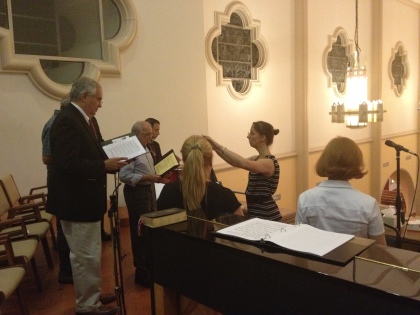
The Schola Cantorum of Sts. Francis and Clare sings under the direction of Dr. Jennifer Donelson
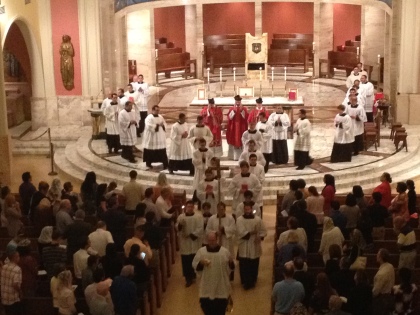
Procession of clergy and seminarians at the conclusion of the Mass
The Aesthetics and Pedagogy of Charles Tournemire: Chant and Improvisation in the Liturgy
September 18, 2012
Following our successful conference in Miami in February, the CMAA is teaming up with Duquesne University to present another conference on Tournemire.
The registration deadline is Friday, September 28, 2012.
www.musicasacra.com/tournemire
The Church Music Association of America in collaboration with
Duquesne University, Pittsburgh, Pennsylvania
and the Pittsburgh Chapter of the American Guild of Organists
present
The Aesthetics and Pedagogy of Charles Tournemire: Chant and Improvisation in the Liturgy
October 21-24, 2012
The Church Music Association of America will hold a conference exploring the legacy of Charles Tournemire as an improviser and teacher of improvisation on October 21-24, 2012 on the campus of Duquesne University in Pittsburgh and at neighboring Pittsburgh churches. The conference seeks to explore the aesthetic, liturgical, theoretical, and technical principles of Tournemire’s improvisations and teachings on improvisation, the use of Gregorian chant in organ improvisation, the role of organ improvisations in the Catholic liturgy, and pedagogical approaches to teaching organ improvisation.
The conference will include liturgies, opportunities for the study of improvisation at the organ, recital programs and papers relating to the conference theme.
Florida Pro Musica in Orlando
May 17, 2012
Musica Sacra Florida Registration Deadline Extended
March 31, 2012
The registration deadline has been extended to Monday, April 9th.
To register, please visit: www.musicasacra.com/florida.
Introduction to the Latin Mass – Tampa
March 27, 2012
Complete information available here.
Introduction to the Latin Mass
The Holy Sacrifice of the Mass was celebrated in the Extraordinary Form (in Latin) for over 400 years. With the advent of the Second Vatican Council, not only did the words and the language of the Mass change, but so did the structure. As part of our Catholic heritage, this form of the Mass has played a large part in the development of our Catholic identity and is the basis of the Ordinary Form of the Mass that most of us are familiar with today.
These three introductory sessions will explore the basics of the Latin Mass in order to give a better understanding of the words, language, and structure of this most holy prayer.
Whether the Latin Mass was the Mass you grew up with, only heard stories about, is the Mass you currently attend, or is simply something you want to learn more about, please join us as we explore an introductory overview of this form of the Holy Sacrifice.
The Introduction is divided into three separate Sunday sessions, with different information presented at each session. For those who cannot attend the afternoon sessions on Sunday, the same information will be presented in the Saturday morning sessions. That is, for a given weekend, you can attend either the Saturday or Sunday sessions as the information on a particular weekend will be the same. However, each consecutive weekend session will build on the previous weekend session’s information; therefore, we encourage you to try to attend all three.
We will wrap it all up by having a celebration of the Extraordinary Form of the Mass (a Latin Mass) on Sunday, May 6th, beginning at 4:00pm at Incarnation Catholic Church.
We hope this experience will assist you in gaining a respect and appretiation for the Extraordinary Form of the Holy Sacrifice of the Mass that is such a rich part of our Catholic heritage. We also hope this experience will assist you in gaining a better appreciation and a deeper love for the Ordinary Form of the Holy Sacrifice of the Mass that we have all become so familiar with over the last 40 years.
May God continue to bless you and draw you into a deeper love for His Son Jesus in and through the most perfect prayer of the Holy Mass.
Musica Sacra Florida 2012 – Gregorian Chant Conference
February 24, 2012
Musica Sacra Florida – Gregorian Chant Conference
Sponsored by the Florida Chapter of the Church Music Association of America in conjunction with the Department of Music, Ave Maria University, Ave Maria, Florida.
Friday, April 13th – Saturday, April 14th, 2012
Ave Maria University
Brochure and tentative schedule available here: www.musicasacra.com/pdf/MusicaSacraConference.pdf
The conference includes:
Choice of Intensive Study Tracks in:
– Gregorian Semiology
– Gregorian Chironomy (Conducting)
– Singing Gregorian Chant in English
– Church Documents & Sacred Music History of the 20th and 21st centuries
– Clergy Training
Choice of scholae for beginning/intermediate (men & women), upper-level men, & upper-level women
Missa cantata in the Extraordinary Form on Friday evening
Closing Missa cantata in the Ordinary Form on Saturday evening
This two-day workshop will present beginning, intermediate, and advanced musicians with rehearsals and lectures that will enrich their knowledge of Gregorian chant and its use in the Roman Catholic liturgy. The theme of this year’s conference will be the call of Pope Benedict XVI for reform in continuity with Tradition and the mutual enrichment of the Ordinary and Extraordinary Forms of the Mass as described by the Holy Father in his 2007 motu proprio Summorum Pontificum.
Led by a faculty of chant specialists from around the state, attendees will have opportunities for in-depth study of single topics. There will be five intensive study tracks each for the study of Gregorian Chironomy (conducting), Gregorian Semiology, Gregorian Chant in English, Church Documents and History of Sacred Music in the 20th and 21st Century, and a Clergy Training Track.
Beginning chanters will be introduced to the basics of notation and rhythm according to the classic Solesmes method. Experienced chanters will learn new repertoire and advance their understanding of rhythmic and interpretive nuance. Resources and practical methods for the cultivation of Gregorian chant in the life of the parish will also be discussed, especially in light of the new missal. This year there will be a special emphasis on Gregorian chant in English, along with Latin chant.
This workshop is ideal for choir members, parish music directors, music students, teachers, parents, seminarians, priests, deacons and anyone who is interested in learning about the heritage of sacred music within the Roman Catholic Church.
Registration fees are $60 ($15 for clergy and students with ID) and include the price of instructional materials and instruction.
Overnight accommodations will be available at AMU’s Xavier Conference Center. Participants can choose among various options for room and board. For prices and options, visit www.musicasacra.com/florida.
Carpools from Miami/Fort Lauderdale to the conference are also available. Visit the conference website for more details.
Pre-registration and payment are required. Deadline: Friday, March 30th, 2012
Contact Information:
Susan Treacy
(239) 280-1668 or susan.treacy@avemaria.edu
Faculty:
Keynote Speaker – Susan Treacy – Ave Maria University, Ave Maria, FL
Mary Jane Ballou – Director of the Schola Cantorae, St Augustine, FL
Jennifer Donelson – Nova Southeastern University, Fort Lauderdale, FL
Jeffrey Herbert – Director of Music, Our Lady Queen of Martyrs Church, Sarasota, FL
Rev. Fr. Christian Saenz, SJ – Chaplain, Belen Jesuit Prep, Miami, FL
Edward Schaefer – University of Florida, Gainesville, FL
To register, visit: www.musicasacra.com/florida
A video of the Mass is available for download here: http://www.livemass.net/LiveMass/Live.html
The video can also be streamed on youtube here:
Special thanks to Fr. James Fryar, FSSP for making the filming possible and the video available.
Photos courtesy of Ana Rodriguez-Soto, Florida Catholic
Other photos of the Mass available at the conference post below.
CMAA Conference Report – Gregorian Chant and Modern Composition for the Catholic Liturgy: Charles Tournemire’s L’Orgue Mystique as Guide
February 22, 2012
Gregorian Chant and Modern Composition for the Catholic Liturgy: Charles Tournemire’s L’Orgue Mystique as Guide
Conference Summary
From February 1-3, 2012, performers and scholars from across the U.S. and five foreign countries gathered for a symposium on Charles Tournemire, sponsored by the Church Music Association of America, Nova Southeastern University in Fort Lauderdale, Florida, the Church of the Epiphany in Miami, Florida, and the Priestly Fraternity of St. Peter.
A new initiative of the CMAA, organized by Dr. Jennifer Donelson of Nova Southeastern University, the aim of the conference was to explore the aesthetic, liturgical, and compositional principles of L’Orgue Mystique, the implications of the work for modern compositions inspired by Gregorian chant, and the role of modern compositions and the organ in the Catholic liturgy.
The opening recital of the conference was given at the Church of the Epiphany in South Miami by Mr. Jonathan Ryan, First Prize Winner of the Jordan International Organ Competition and Visiting Artist at St. James Cathedral (Episcopal) in Chicago. In the model of recitals given by Tournemire himself, Ryan presented a delightful snapshot of the modal and chorale-based tradition to which Tournemire claimed not only compositional lineage, but also artistic allegiance. Versets by de Grigny and excerpts from Frescobaldi’s Fiori Musicali opened the program in a colorful display of the variety offered by the liturgical organ repertoire of the 17th century. The Paraphrase-Carillon from Tournemire’s office from L’Orgue Mystique for the Assumption marked the center place in the program, and the melodic wealth of Tournemire’s use of Marian chants was highlighted by Ryan’s supple sense of rhythm and phrasing. Three tune-based compositions by Buxtehude (Chorale Prelude on Komm Heiliger Geist), Sweelinck (Variations on Puer nobis nascitur) and Böhm (Chorale Prelude on Vater Unser im Himmelreich) followed, the combination itself an ingenious Trinitarian prelude to the masterpiece of Trinitarian symbolism, the “St. Anne” Prelude and Fugue by Bach. Ryan’s exhilarating playing highlighted the immense diversity of sound in the organ repertoire to which Tournemire was drawn, and the fantastic possibilities opened up when playing the repertoire on an organ of symphonic scope.
The second day of the conference was marked by a series of recitals at the Church of the Epiphany in South Miami, organized with the generous assistance and support of Mr. Thomas Schuster, Director of Music and Organist at Epiphany. The first recital of the day was given by Dr. Crista Miller of the Co-Cathedral of the Sacred Heart in Houston who framed her program with two works by Naji Hakim (Embrace of Fire and the Te Deum). The ferocity and rhythmic vigor of Miller’s playing of the Hakim was contrasted with the sweet repose offered by the interior of the program – the sublime Soleil du Soir from Langlais’ 1983 Cinq Soleils and Tournemire’s anguished and introspective office from L’Orgue Mystique for the Feast of the Sacred Heart. A recital of three of Tournemire’s pièces terminales from L’Orgue Mystique followed, given by Mr. Richard Spotts of Doylestown, PA. The recital, just one of a multiple-year series given by Spotts which will culminate in the playing of the complete L’Orgue Mystique, featured the offices of Pentecost, the Third Sunday after Epiphany, and the feast of St. Joseph. Spotts’ sensitive and thoughtful playing reflected the depth of his understanding of the repertoire offered by his extensive work with the cycle.
The third program in the morning series of recitals was a premiere of two works by Christendom College (Front Royal, VA) faculty member, Dr. Kurt Poterack played by Mr. Matthew Steynor of Trinity Cathedral (Episcopal) in Miami. Both of the works featured the prominent use of Gregorian chants, the Eucharistic Suite employing Ave verum, Jesu dulcis memoria, and Ecce panis angelorum, and his Meditation on the Glorious Mysteries employing mostly the introits of the Masses connected to each mystery. Of special note were the variations on Ecce panis angelorum in the final movement of the Eucharistic Suite – a delightfully varied salute to both the tune and the French 20th-century tradition of chant-based compositions.
The morning concluded with an insightful lecture by Dr. Ann Labounsky (Duquesne University) replete with pertinent quotes from Tournemire’s own writings on improvisation, especially from his Précis d’éxécution de registration et d’improvisation à l’orgue. Labounsky’s lecture focused on Tournemire’s work as a teacher of improvisation, and her recital of works by Franck, Tournemire, and Langlais following the lecture illustrated Tournemire’s work specifically within the Ste. Clotilde tradition as well as her own astute and well-deserved place in this lineage of players and pedagogues.
The first recital of the afternoon was an ambitious and imaginative project – a chronology of improvisations in the French style by Dr. Bogusław Raba (Musicology University of Wrocław, Poland.) Working his way from Titelouze and a Baroque organ Mass through the styles of Franck, Widor, Guilmant, and Vierne to those of Duruflé, Dupré, Langlais, and Messiaen, Raba displayed an impressive command of disparate styles. The afternoon concluded with a pair of recitals featuring new music, the first given by Timothy Tikker (University of Michigan) which included one of his compositions based on the Te Deum, along with three pieces from Tournemire’s offices for Epiphany, the Third Sunday of Advent, and the Most Holy Trinity. Tikker’s perceptive handling of the diversity of texture and structural flow of Tournemire’s works, especially of the Toccata from Advent III, was particularly noteworthy. The second recital in the pair feature the Hildegard Organ Cycle by Frank Ferko and was performed by Dr. Chad Winterfeldt (Gustavus Adolphus College), assisted by Mrs. Lisa Knutson (Cathedral of St. Joseph, Sioux Falls) who sang the chants upon which the selected movements were based. The effect of the barrage of tone clusters in the fifth movement (Places of Purification) when released into the reverberant acoustic at Epiphany at the conclusion of the movement was profoundly striking, as was Winterfeldt’s luminous registration of the fourth movement (Articulation of the Body.)
The final recital of the evening was given by Dr. Ronald Prowse (Sacred Heart Seminary, Detroit). His selections (Dupré’s variation on Ave maris stella from his Op. 18, Peeters Toccata, Fugue and Hymn on the same, and the pièce terminale of Tournemire’s office for the Immaculate Conception) proved to be an outstanding preparation for the Mass of the Marian feast day which immediately followed, aided especially by Prowse’s technically brilliant delivery of the Dupré as well as a profoundly meditative performance of the Tournemire.
Thursday, February 2 concluded with a Solemn Pontifical Mass in the Extraordinary Form of the Roman Rite (Missale Romanum of 1962) celebrated by His Excellency, Thomas G. Wenski, Archbishop of Miami, the first such Mass celebrated in nearly 50 years in the Archdiocese of Miami. Organized through the generous efforts of Fr. Brian Austin (FSSP) and the Priestly Fraternity of St. Peter working in conjunction with the Archdiocese, the Mass drew a crowd of approximately 1300 worshippers. The musical highlights of the Mass included Tournemire’s office from L’Orgue Mystique for the day (Purificatio B. Mariæ Virginis), played by Mr. Thomas Shuster (Epiphany Church, Miami) a Missa Brevis by Zachary Wadsworth, and a commissioned motet on the Nunc dimittis by Dr. Paul Weber, both performed by the Florida Schola Cantorum under the direction of Dr. Edward Schaefer. The Gregorian chant propers of the Mass were sung by a women’s schola cantorum, consisting largely of the Servants of the Pierced Hearts of Jesus and Mary who form the schola cantorum at St. Michael the Archangel Parish in Miami, under the direction of Dr. Jennifer Donelson. The assistant clerics were Very Rev. Msgr. Andrew Wadsworth (Westminster, England), Rev. Fr. Guy Nicholls (Birmingham Oratory), Rev. Fr. Richard Vigoa, Very Rev. Fr. Christopher Marino, Rev. Fr. Joseph Fishwick and Very Rev. Msgr. Jude O’Doherty (Archdiocese of Miami), Rev. Fr. Christian Saenz (Society of Jesus), Rev. Fr. James Fryar, Rev. Fr. Justin Nolan and Rev. Fr. Brian Austin (Priestly Fraternity of St. Peter). Servers and other ministers were drawn from St. John Vianney College Seminary, the Church of the Epiphany, and the Mission of Sts. Francis and Clare in Miami.
A complete video of the Mass, courtesy of the Fr. James Fryar (FSSP) at www.livemass.net can be viewed by clicking here. Also, a story produced by the Archdiocesan newspaper, complete with more photos of the event is available by clicking here.
The events of Friday, February 3 took place in the Performing and Visual Arts Division at the main campus of Nova Southeastern University in Davie, FL. The first panel of papers began with a presentation by Msgr. Andrew Wadsworth (Executive Director, ICEL) who drew upon magisterial documents, liturgical praxis, and first-hand experience to craft a snapshot of the role of the organ in liturgy:
“There is something about the sound of the organ – its ability to produce every dynamic level from inaudible to deafening, and every frequency from too low to hear to too high to hear, which gives it a cosmic character, and it is only really improvisation that can explore to the full, the dimensions available in a particular space and for a particular liturgical moment. Such music is being created for that space, that organ and that liturgy in real time. An improvisation at the end of Mass in particular, can be seen as offering a response to the the liturgy on behalf of the people – a huge wordless but musical Deo gratias. Such moments, in the hands of a good player, give the organ an oratorical power – in a very real sense, it can preach to the people.”
The presentation which followed, given by Dr. Edward Schaefer, drew together an enormous body of liturgical documents and organ repertoire from 16th and 17th century Italy, and 17th and 18th century France to examine the place of Tournemire’s L’Orgue Mystique within the organ Mass tradition. Of particular note were Schaefer’s speculations about the potential use of Tournemire’s work at either low or high Mass, based on French liturgical practices immediately preceding the appearance of L’Orgue Mystique, as well as the observations of Tournemire students about his playing at the low Mass at Ste. Clotilde.
Dr. Susan Treacy’s presentation on the role of Joseph Bonnet in the Gregorian revival in Paris was particularly useful in situating Tournemire’s work in the broader context of sacred music revival in early 20th-century France (and Paris in particular.) Also of great interest was her exploration of Bonnet’s fascinating and far-reaching work as a whole, a little-explored topic, particularly in English-language scholarship. She drew together quotes from various writings of Bonnet, linking him in a vital way not only to the revival of chant at Solesmes, but also to the sacred music renewal happening in the U.S. through the hands of people like Mrs. Justine Ward.
The early morning session concluded with a rousing account of Dr. Robert Sutherland Lord’s lifetime of experience with Tournemire’s manuscripts, personal affects, and friendship with Mme. Tournemire. Scholars of Tournemire’s L’Orgue Mystique are well-acquainted with Dr. Lord’s work on the cycle, particularly his 1984 Organ Yearbook article on the work. Lord’s as-of-yet uncompleted work which was the focus of his presentation, however, is the compilation of a catalogue for the 1300 page rough draft of L’Orgue Mystique left to the Bibliothèque Nationale by Tournemire’s student, Daniel-Lesur, a manuscript not included in Joel-Marie Fauquet’s catalogue of Tournemire’s works. His discussion of the manuscript explored its role as an important bridge between Tournemire’s “plan” for LOM and the final form of the work.
The second session of the morning began with a paper by Elisabeth Kappel (University of Music and Performing Arts, Graz, Austria) which documented Tournemire’s methods for chant paraphrase in the first four movements of the offices of L’Orgue Mystique for the feast of the Immaculate Conception, Christmas, Epiphany, and the Purification of the B.V.M., drawing together some general trends in Tournemire’s approach.
The second paper of the session by Dr. Bogusław Raba (Musicology University, Wrocław, Poland) explored the harmonic language of L’Orgue Mystique as a whole, setting up a dialectic between pandiatonicism and chromaticism wherein pandiatonicism functions as a static and mystical element, and chromaticism serves as a dynamic and transformative language. Raba pointed to the synthesis arising from this dialectic as particularly suited towards a truly sacred music which is, by definition, both transcendental and immanent, eternal and temporal.
The presentation given by Timothy Tikker (University of Michigan) which followed was an exploration of performance practice issues connected with L’Orgue Mystique. Tikker’s presentation focused on rhythmic elements, including the use of rubato and suppleness of phrasing in melodic lines. He presented a number of recording excerpts illustrative of Tournemire’s own sense of rubato, as well as Tournemire’s comments on the performance of Franck, etc.
The morning sessions concluded with a presentation by Dr. Ronald Prowse (Sacred Heart Seminary, Detroit) which compared Tournemire’s improvisations with his compositions. By way of illustration, Prowse focused on the Postlude from Tournemire’s office for the Immaculate Conception and Tournemire’s 1931 improvisation on Ave maris stella. Tournemire’s approach was then contrasted with the improvisational approach of Dupré, allowing a portrait of an inspired Tournemire to emerge.
The keynote address, given by Dr. Stephen Schloesser (Loyola University, Chicago), focused on the vital connection between text and music in L’Orgue Mystique, situating the work in the symbolist movement in general, and Tournemire’s symbolist tendencies throughout his oeuvre. Schloesser discussed the importance of the texts not only of the chant, but also of Guéranger’s meditations on them in his multi-volume Liturgical Year, demonstrating that Tournemire intended a sort of textual exegesis in his compositions. Comparing the presentation (in published form) of Tournemire’s work with that of a highly-texted (and more successful) Messiaen, Schloesser argued not only that Tournemire might have been more successful in achieving recognition and appreciation of L’Orgue Mystique had he included relevant quotations from the chants with each movement, but also that Tournemire himself perhaps saw his mistake in not doing so as evidenced by subsequent publications which prominently displayed textual references, as well as concert program(s) of LOM which did likewise.
The final session of papers focused on teacher and student relationships to Tournemire, beginning with two papers on Messiaen and Tournemire. Elizabeth McLain (University of Michigan) focused her discussion of the relationship between the two on an analysis of Tournemire’s influence on Messiaen’s L’Ascension. McLain compared Tournemire and Messiaen’s use of chant, noting their similar penchant for paraphrase technique, but distinguishing the practice thereof most particularly through Messiaen’s reworking and abstraction of chant melodies into his own musical language. Through various musical examples drawn from the orchestral version of Messaien’s work, McLain demonstrated the effective combination of new techniques with those adopted and adapted from Tournemire in an effective portrayal of the subject matter.
The second paper on Messiaen, given by Dr. Jennifer Donelson (Nova Southeastern University), compared Tournemire and Messiaen’s notions of sacred music, focusing on the composers’ common inspiration in Ernest Hello. Situating the study of art in the realm of man working with matter and apart from aesthetics, Hello’s writings focused on the embodiment of artistic inspiration, through individual style, in the well-executed work of art, noting the impossibility of complete attainment of the ideal in the work of art itself. The striving for the ideal and the lack of complete fulfillment in art provided a poetically philosophical encapsulation of the eschatological element in sacred music for both composers. Through his understanding of Aquinas, Messiaen pushed this shared insight further, noting the bedazzling effect of God’s truth on the intellect and striving for an analogical bedazzlement in his own works. The relationship of the oeuvres of Messiaen and Tournemire to the liturgy and concert hall was also explored.
The relationship of Tournemire to his cher Maître, César Franck, was probed in a paper by R.J. Stove (Organ Australia, Melbourne) on Tournemire’s biography of Franck. Stove’s discussion of the biography demonstrated the success in the volume at stating more about Tournemire than about Franck, given its often high tone and scope. Stove noted that a person reading the biographies of Franck written by both d’Indy and Tournemire would never have suspected that Tournemire studied with Franck for a much shorter period than d’Indy, since Tournemire’s biography desperately attempts to point to the very mind and soul of Franck’s compositions and teaching in a manner that eclipses d’Indy’s efforts. Stove pointed out however, that the biography does serve as an effective means of understanding the enormous impact of Franck on Tournemire.
The final paper of the conference was given by Dr. Crista Miller (Co-Cathedral of the Sacred Heart, Houston) on the work of Naji Hakim as a successor to the Ste-Clotilde tradition of chant-based compositions. After first discussing the general characteristics of Hakim’s compositions (the use of Maronite chant, maqam and Arab scales, eastern instrumental effects, etc.), Miller drew fascinating comparisons between Hakim and Tournemire’s settings of chants for the feast of the Sacred Heart in Embrace of Fire and the office for the Most Sacred Heart of Jesus respectively. Of particular note was Miller’s discussion of the history of the evolution of the propers for the feast of the Sacred Heart near the point of composition/publication of L’Orgue Mystique and Tournemire’s use of the superseded propers, thus making his office for the feast day “outdated” from the moment of its publishing.
The conference concluded with a recital by Dr. Rudy de Vos, Organist and Director of Music at the Cathedral of Christ the Light (Oakland, CA.) Bookending the first section of the recital were works by Tournemire – first, the transcription of Tournemire’s improvisation on Victimae paschali laudes, and then, fittingly, the last office of the liturgical year and the last composed of L’Orgue Mystique, the office for the 23rd Sunday after Pentecost, issuing an emphatic Deo gratias in its prominent use of the Te Deum. Placed between the works by Tournemire were Vierne’s lyrical Méditation (from Trois Improvisations), the relentlessly creative Fugue and Caprice No. 9 of Roberday and the wide-ranging Grand Dialogue of Marchand, at times majestically exuberant and at others delicately lyrical. The crown jewel of de Vos’s playing on Friday evening, however, was his masterful treatment of Franck’s 2nd Chorale. The recital concluded with a delightful Toccata by Marcel Lanquetuit.
Plans are forthcoming for the publication of a volume including the conference papers, as well as the creation of a repository for some of the recordings of recitals from the conference. For updates on the progress of these endeavors, visit www.musicasacra.com/tournemire.
A pdf of the conference summary, complete with embedded photos, can be downloaded by clicking here.

